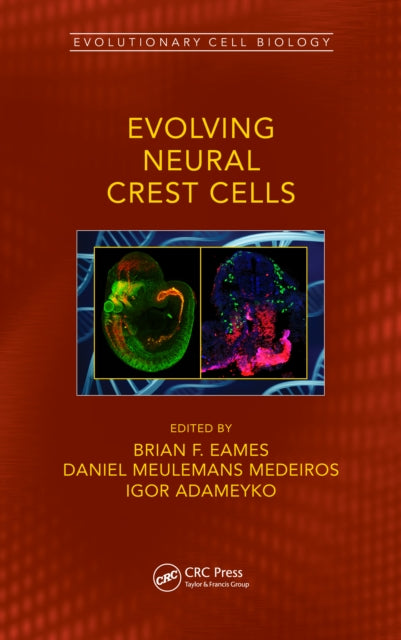Shulph Ink
Evolving Neural Crest Cells
Evolving Neural Crest Cells
YOU SAVE £2.50
- Condition: Brand new
- UK Delivery times: Usually arrives within 2 - 3 working days
- UK Shipping: Fee starts at £2.39. Subject to product weight & dimension
Bulk ordering. Want 15 or more copies? Get a personalised quote and bigger discounts. Learn more about bulk orders.
Couldn't load pickup availability
- More about Evolving Neural Crest Cells
Vertebrates possess lineage-specific characteristics, including paired anterior sense organs and a robust, modular head skeleton built of cellular cartilage and bone. The evolutionary history of the neural crest, and neural crest cells, has been difficult to reconstruct. This volume will use a comparative approach to survey the development of the neural crest in vertebrates and neural crest-like cells across the metazoa, revealing neural crest evolution and identifying genomic, genetic, and gene-regulatory changes that drove them.
Format: Paperback / softback
Length: 294 pages
Publication date: 29 April 2022
Publisher: Taylor & Francis Ltd
Vertebrates, a diverse group of animals, possess a remarkable set of lineage-specific characteristics that set them apart from other organisms. These features include paired anterior sense organs, a robust, modular head skeleton composed of cellular cartilage and bone, and a unique embryonic tissue known as the neural crest.
The neural crest is a specialized tissue that arises during embryonic development and plays a crucial role in the formation of various structures in vertebrates. It is derived from the ectoderm, the outer layer of the embryonic tissue, and gives rise to a diverse array of cells and tissues that contribute to the development and diversification of vertebrate bodies.
One of the most notable characteristics of vertebrates is their head skeleton. The skull, which houses the brain and other sensory organs, is made up of a series of interconnected bones that are derived from the neural crest. The skull is not only robust but also highly modular, allowing for the evolution of complex head structures in different vertebrate groups.
Another important feature of vertebrates is their anterior sense organs. These include the eyes, ears, nose, and tongue, which are all derived from the neural crest. The eyes, in particular, are highly complex organs that allow for vision and have undergone significant evolution in different vertebrate groups.
The evolutionary history of the neural crest and neural crest cells has been a subject of intense research in recent years. The development of the neural crest is believed to have played a crucial role in the diversification of vertebrate heads and bodies. However, the exact mechanisms that drive neural crest evolution and the genetic changes that underlie these processes are still not fully understood.
This volume aims to provide a comprehensive survey of the development of the neural crest in vertebrates and neural crest-like cells across the metazoa. It will use a comparative approach to examine the similarities and differences in the formation and function of neural crest cells in different vertebrate groups. The information gathered in this volume will be used to reveal the evolutionary history of the neural crest and identify the genomic, genetic, and gene-regulatory changes that drove them.
One of the key hypotheses proposed in this volume is that the origin of neural crest cells involved the novel co-activation of ancient metazoan gene programs in neural border cells. This hypothesis suggests that the evolution of the neural crest was driven by the integration of ancient genetic programs that were previously inactive in vertebrate embryos. The co-activation of these ancient gene programs led to the formation of new cell types and tissues, including the neural crest and its derivatives.
The emergence of the neural crest also made possible the diversification of vertebrate heads. The modular head skeleton and the anterior sense organs derived from the neural crest allowed for the evolution of a wide range of head structures and behaviors in different vertebrate groups. For example, fish have developed sophisticated sensory systems that allow them to detect and respond to environmental stimuli, while mammals have developed complex cognitive abilities that enable them to learn and adapt to their environments.
In conclusion, vertebrates possess a remarkable set of lineage-specific characteristics that are derived from the unique embryonic tissue known as the neural crest. The neural crest is responsible for the formation of various structures in vertebrates, including the head skeleton, anterior sense organs, and other tissues and cells. The evolutionary history of the neural crest and neural crest cells has been difficult to reconstruct, but this volume aims to provide a comprehensive survey of the development of the neural crest in vertebrates and neural crest-like cells across the metazoa. The information gathered in this volume will be used to reveal the evolutionary history of the neural crest and identify the genomic, genetic, and gene-regulatory changes that drove them.
Weight: 540g
Dimension: 234 x 156 (mm)
ISBN-13: 9780367522742
This item can be found in:
UK and International shipping information
UK and International shipping information
UK Delivery and returns information:
- Delivery within 2 - 3 days when ordering in the UK.
- Shipping fee for UK customers from £2.39. Fully tracked shipping service available.
- Returns policy: Return within 30 days of receipt for full refund.
International deliveries:
Shulph Ink now ships to Australia, Belgium, Canada, France, Germany, Ireland, Italy, India, Luxembourg Saudi Arabia, Singapore, Spain, Netherlands, New Zealand, United Arab Emirates, United States of America.
- Delivery times: within 5 - 10 days for international orders.
- Shipping fee: charges vary for overseas orders. Only tracked services are available for most international orders. Some countries have untracked shipping options.
- Customs charges: If ordering to addresses outside the United Kingdom, you may or may not incur additional customs and duties fees during local delivery.


